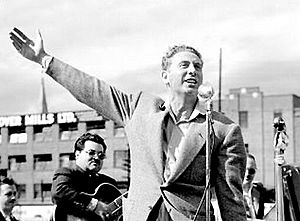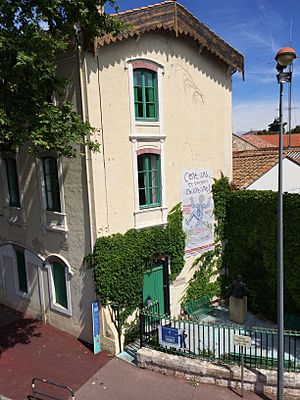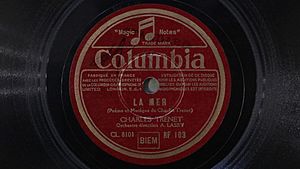Charles Trenet facts for kids
Quick facts for kids
Charles Trenet
|
|
|---|---|

|
|
| Background information | |
| Birth name | Louis Charles Augustin Georges Trenet |
| Born | 18 May 1913 Narbonne, France |
| Died | 19 February 2001 (aged 87) Créteil, France |
| Genres | Jazz, easy listening |
| Instruments | Vocals |
| Years active | 1933–1999 |
| Labels | Pathé-Marconi, Columbia |
Charles Trenet (born Louis Charles Augustin Georges Trenet; May 18, 1913 – February 19, 2001) was a very famous French singer and songwriter. He wrote both the music and words for almost a thousand songs during his career. This amazing career lasted for more than 60 years!
Some of his most well-known songs include "Boum!" (from 1938), "La Mer" (from 1946), and "Nationale 7" (from 1955). Charles Trenet also worked with other talented musicians like Michel Emer and Léo Chauliac. He received an Honorary Molière Award in 2000 for his contributions to music.
Contents
Charles Trenet's Music
Charles Trenet created many popular songs. Some of his most famous ones are "Boum!", "La Mer", "Y'a d'la joie", "Que reste-t-il de nos amours?", "Ménilmontant", and "Douce France". He wrote nearly a thousand songs in total!
Some of his songs were quite unique and imaginative. They used playful images that almost seemed like dreams. For example, "Y'a d'la joie" describes happiness with strange pictures. It talks about a subway car flying out of its tunnel or the Eiffel Tower walking across the street. These creative ideas made his songs special. Many of his hits from the 1930s and 1940s mixed French song styles with American swing rhythms.
His song "La Mer" is one of his most famous. People say he wrote it with Léo Chauliac on a train in 1943. However, it wasn't recorded until 1946. Trenet once said that people told him "La Mer" wasn't "swingy" enough to be a hit. So, he kept it hidden for three years before it was finally recorded.
"La Mer" is Trenet's most famous song outside of France. More than 400 different versions of it have been recorded! The tune was given new English words and a new title, "Beyond the Sea". This version became a hit for Bobby Darin in the early 1960s and George Benson in the mid-1980s. You might have heard "Beyond the Sea" in the ending credits of the movie Finding Nemo.
Another Trenet song that became popular in English is "Que reste-t-il de nos amours?". A lyricist named Albert Beach changed it into "I Wish You Love". Keely Smith first recorded "I Wish You Love" in 1957. Since then, many artists like Frank Sinatra and Sam Cooke have also sung it.
Other French singers, such as Maurice Chevalier and Jean Sablon, also recorded Trenet's songs.
Early Life and Artistic Beginnings

Charles Trenet was born in Narbonne, France, on May 18, 1913. His parents were Françoise and Lucien Trenet. When he was seven years old, his parents separated. He was sent to a boarding school, but he soon returned home because he became sick. While he was recovering at home, he started to develop his artistic talents. He began to enjoy music, painting, and sculpting.
In 1922, Trenet moved to Perpignan and attended school there. A family friend who was a painter, André Fons-Godail, often took him out to paint. People say that Trenet's poetry and songs show a painter's eye for detail and color. Many of his songs mention places near Narbonne, like the Pyrenees mountains and the Mediterranean coast.
He finished school with good grades in 1927. After school, he went to Berlin to study art. He also briefly studied at art schools in France. When Trenet first arrived in Paris in the 1930s, he worked in a movie studio. He helped with props and was an assistant. Later, he joined other artists in the Montparnasse neighborhood. Two things greatly influenced Trenet's songs: his admiration for the poet Max Jacob and his love for jazz music.
Before World War II
From 1933 to 1936, Charles Trenet worked with a Swiss pianist named Johnny Hess. They formed a duo called Charles and Johnny. They performed in many places in Paris and recorded 18 songs together. Their most successful song was "Quand les beaux jours seront là/Sur le Yang-Tsé-Kiang". In their recordings, Johnny Hess played the piano, and they often sang together in harmony. Around 1935, they also appeared regularly on a radio show.
The duo continued until 1936 when Trenet had to join the national service. After this, he received a nickname that stayed with him his whole life: "Le Fou chantant," which means "The Singing Madman." He started his solo career in 1937, recording his first songs like "Je chante/Fleur bleue". The joyful song "Je chante" made people think of Trenet as a "singing traveler." This idea appeared in many of his early songs and films. He became famous very quickly. The famous writer Jean Cocteau said that when Trenet sang, he was "so young, so fresh" that the stage seemed to transform around him.
During World War II
When World War II began, Trenet was called to serve in the military. He was in a barracks until June 1940, when he moved back to Paris. During the war, he performed in famous cabarets like the Folies Bergère. Many German officers and soldiers were in the audience. There were some false rumors that his name "Trenet" was a Jewish name. He was able to prove his family background to the authorities.
Like many other artists at that time, he chose to continue performing. This allowed him to keep his career going. He also agreed to sing for French prisoners-of-war in Germany when asked. After the war, there were official investigations into whether artists had supported the occupying forces. Trenet was investigated, but he only received a warning and faced no further problems.
After World War II
After the war ended, Charles Trenet moved to the United States for a few years. He quickly became very successful there. After some concerts in New York City, Hollywood became interested in him. He met famous musicians like Louis Armstrong and became good friends with Charlie Chaplin.
On September 14, 1951, Trenet returned to Paris and performed again at the Théâtre de l'Étoile. He included ten new songs in his show. In 1954, he performed at the famous Olympia music-hall in Paris for the first time. The next year, he wrote the well-known song "Route nationale 7". This song was a tribute to the new idea of paid holidays for workers.
In 1958, Trenet was the main performer at two other famous venues, the Bobino and the Alhambra. In 1960, he returned to the Théâtre de l'Étoile. This time, he appeared on stage without his famous trilby hat, which had been part of his act for a long time.
Later Career and Final Years
In 1970, Trenet traveled to Japan to represent France at a big exhibition in Osaka. The next year, he left his longtime record company, Columbia, and recorded new songs. He also had a memorable performance at the Olympia.
In 1973, Trenet celebrated his 60th birthday and recorded a new album called Chansons en liberté. This album had a mix of old and new songs. His 60th birthday was a big celebration in the French media.
In 1975, Trenet surprised everyone by announcing he was retiring from music. After his last concert at the Olympia, he said an emotional goodbye to his audience. After his mother passed away in 1979, he stayed away from the public for two years.
However, in 1981, Trenet made a comeback with a new album. This album was about his childhood memories. After this, Trenet returned to a quiet life, but he would sometimes perform for special events in France or other countries. After giving farewell concerts in France, a lawyer from Canada, Gilbert Rozon, convinced Trenet to perform one more farewell concert in Montreal in 1983. Rozon then became Trenet's manager. As a result, Trenet performed many more concerts, including a series of shows in Paris in 1986.
On May 21, 1999, he released a new album called Les poètes descendent dans la rue (Poets Take to the Streets). After the album came out, Trenet started performing live again.
In April 2000, Trenet had a stroke and had to go to the hospital. He spent several weeks recovering. By the autumn of that year, he was well enough to attend a rehearsal for Charles Aznavour's show on October 25. This was his last public appearance.
In November 2000, the house where Trenet was born in Narbonne was turned into a small museum. Visitors could see items from Trenet's childhood and family life. They could also see original drafts of his famous songs.
Charles Trenet passed away three months later, on February 19, 2001, after having another stroke.
In 2017, a rest stop on a highway in France was named in his honor. It has an exhibition about his life and work.
Honors and Awards
 Commander of the Ordre des Arts et des Lettres (1982)
Commander of the Ordre des Arts et des Lettres (1982) Officer of the Ordre des Palmes académiques (1989)
Officer of the Ordre des Palmes académiques (1989) Commander of the Ordre national du Mérite (1995)
Commander of the Ordre national du Mérite (1995) Commander of the Legion of Honour (1998)
Commander of the Legion of Honour (1998)
Discography
Here are some of Charles Trenet's most famous songs:
- 1933: "L'école buissonnière" (music co-written with Johnny Hess)
- 1936: "Vous oubliez votre cheval"
- 1937: "Je chante"
- 1937: "Fleur bleue"
- 1937: "J'ai ta main"
- 1937: "Vous qui passez sans me voir" (music co-written with Johnny Hess)
- 1937: "Y a d'la joie"
- 1938: "Boum!"
- 1938: "J'ai connu de vous"
- 1938: "Ménilmontant"
- 1938: "La polka du roi"
- 1939: "Il pleut dans ma chambre"
- 1939: "Mam'zelle Clio"
- 1941: "Swing troubadour"
- 1941: "Un rien me fait chanter" (music co-written with Léo Chauliac)
- 1942: "Que reste-t-il de nos amours?" (music co-written with Léo Chauliac)
- 1943: "Douce France" (music co-written with Léo Chauliac)
- 1945: "La folle complainte"
- 1945: "La mer"
- 1947: "Revoir Paris"
- 1948: "France-Dimanche"
- 1948: "Grand-maman, c'est New York"
- 1949: "Mes jeunes années"
- 1951: "L'ame des poetes" (performed with Son Quartette Ondioline)
- 1951: "Le serpent python"
- 1954: "Coin de rue"
- 1955: "La java du diable"
- 1955: "Moi j'aime le music-hall"
- 1955: "Route Nationale 7"
- 1957: "Le jardin extraordinaire"
- 1961: "Kangourou"
- 1963: "La famille musicienne"
- 1969: "Il y avait des arbres"
- 1970: "Au bal de la nuit"
- 1970: "L'oiseau des vacances"
- 1970: "Le revenant"
- 1971: "Fidele"
Images for kids
See also
 In Spanish: Charles Trenet para niños
In Spanish: Charles Trenet para niños




